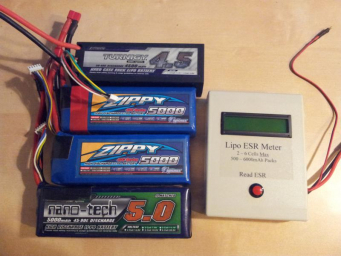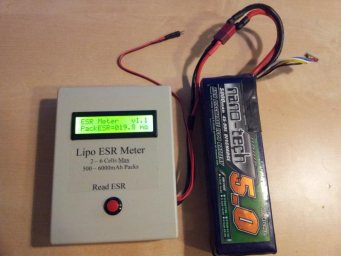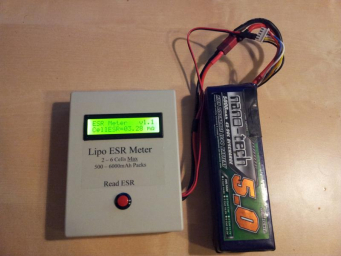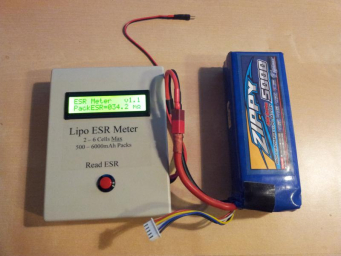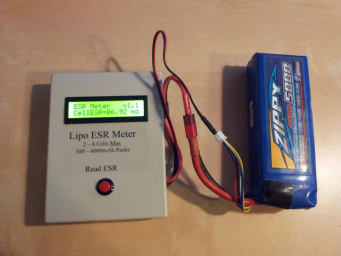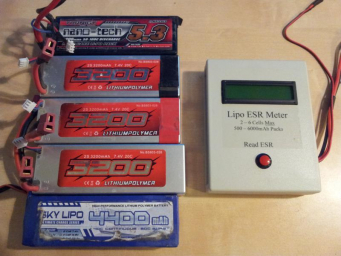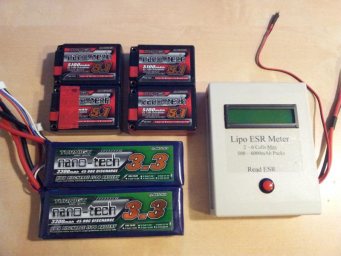I’ve been playing with toy cars long enough to have collected quite a pile of LiPo batteries, even though I’ve done my best to sell some off when I Ebay’d old RC’s I didn’t want any more. Some of the batteries are new, some came used as part of a larger sale, but most of them worked fine. Still, they do degrade over time, and a couple were noticeably down on usable runtime.
I spent some time on Google trying to figure out if there was a way to measure when LiPos go bad: or at least a way to track their deterioration. It turns out the heli/plane RC hobbiests had started to measure their batteries to determine their “Internal Resistance” (IR) or “Effective Series Resistance” (ESR) – packs/cells with higher resistance were less able to sustain voltage under load, and turned more of the current flowing through them into heat. Long story short: low resistance = good, high resistance = bad. I wanted to start recording which brands of batteries were degrading the quickest, so I bought an ESR Meter. Here it is with my 4 4S packs: two Zippys, and two Turnigys:
I had bought the two Zippy’s new, but after 2 summers of running they would constantly bounce off the LVC (low voltage cutoff) if I ran them fast… but would work fine if I drove slow: there was something wrong with them, but I wanted proof. Testing packs was simple: with just the main battery leads hooked up you were measuring the total pack resistance (including wires and Deans connector) under a brief 16a load. Here my used Turnigy nano-tech 5000mah 4S pack was measuring 19.8 mOhms:
With the balance tap plugged into one cell through the battery balance port it would measure the resistance of just that single cell. In this case 3.28 mOhms. This Turnigy battery came used as part of a combo with an RC car, so I don’t know how many times it has been charged, but it has served me well in my RC8Be and RC8Te.
The Zippy batteries showed me the numbers I expected: about 50% higher total resistance of the previous Turnigy (34.2 mOhms):
…and about the same difference in per-cell resistance as well (here 6.92, but as high as 7.36):
When I ran those Zippy packs in my RC8Te they would come off very warm: I knew it was time to retire them but now I have some numbers to back up my decision. Next I fed my other older batteries to the meter: it pointed out one 2S pack with much higher connector resistance (likely a bad solder job, doh!) as well as two packs that seemed OK in a car but the that the meter said were on their way downhill. I’m going to start to record how many charges go through them and measure them again after 10 more cycles.
Finally, the numbers I really wanted to get: resistance from 4 new packs I had just bought from HobbyKing: all Turnigy nano-tech: two 2S saddles for my Losi 22, and two 3S sticks for my Caldera.
The numbers were… in line with what I had read about, but not as low as I had hoped. Average cell resistances were 4.84 and 5.1 mOhms for the saddle packs, and 4.05 and 4.47 mOhms for the stick. Not bad, but not a good as some of my used batteries. The sticks had one charge through them, and the saddles had two: and I had read two things:
- I should charge them at 1C for the first 5-6 cycles or so
- Cell resistance often drops after the first few charges
So, I’m going to wait until I’ve run each pack 5-6 times then start charging at 2C, then measure them again after they’ve reached 10-12 cycles. I’m hoping I see their resistances dip (under 4 would be nice)… then slowly climb with age. Based on the Zippy results, once they get around 6 or higher they’ve reached the end of their usable life (at least with the current draw of an 1/8th-scale brushless setup: 1/10th buggy use may be fine?)
Summary numbers: (all mOhms)
Average for all my new Turnigy cells with 1-2 charges through them: 4.62
Average for my almost-dead cells: 7.13
Average for all my used cells that seem OK when driving: 3.99
Lowest resistance cell: 3.28 in a Turnigy nano-tech 4S 5000mah “40-90C”
Highest resistance cell: 7.36 in a bad Zippy 4S 40C
Average connector/wire resistance (pack resistance, minus per-cell resistances): 6.39
Update: April 2nd 2013
I now have 15 cycles through one of my Turnigy 65-130c 2s 5100 saddle packs, and 17 cycles through the other. One pack dropped average cell ESR from 4.84 to 4.78, and the other increased from 5.12 to 5.34 – so effectively the “actual C” rating of the packs didn’t change. I measured at the same temperature, and after full balance charging. I’ll try to measure them again around 30 cycles.
